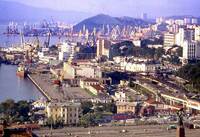Introduction to Part 2: Environmental Impact Design
A certain amount of land use history is contained in the second part of this book. Although it centres on Britain , the stories are uncomfortably similar in other countries. The common pattern struck me after completing the first edition of the book and was outlined in Chapter 1 of this edition. It derives from the universal truths of science and may be common to every land use in every industrialised country:
Pre-industrial multi-purpose planning: land owners aimed to achieve as many types of benefit as they could from the land under their control [Fig 0.2].
Professionalised planning: the professions offered increased efficiency and ouput through the use of specialised scientific techniques.
Industrialised and single-purpose planning: the output of private goods was maximised and that of public goods ignored [Fig 0.3].
Public protest: communities protested at the loss of public goods.
Environmental planning and design: land users are moving towardsï¾ multi-purpose planning.
At present, land users and professions are at different points on the return to multi-purposism, and have different reputations. In Britain , the highway engineer may be the most notorious; the water engineer the most enlightened; the park manager the most blinkered; the quarryman the most unimaginative; the nature conservationist the most devious. Architects and planners are the most vilified by the general public. Landscape architects have the widest objectives and the fewest achievements.
In the mid-twentieth century, rivers were planned only for flood control, farmlands for food production, forests for timber production, military training grounds for war games, roads for vehicular transport, buildings for the benefit of what went on inside their walls. The most scientifically planned of all societies, the Union of Soviet Socialist Republics (USSR) travelled furthest down this particular road to environmental ruin. Not having visited either place, I feel sure that most of the rivers in Vladivostok and Detroit, like those in London, are open sewers in concrete channels, ugly and dangerous, hostile to fishing, swimming and wildlife. Reclaiming the rivers of Vladivostock, Detroit and London will be expensive. But if the environmental impact of every development project is assessed and designed at the planning stage, the modifications will normally impose a small percentage cost on the developer and yield a large percentage benefit to the community. They will also improve the reputation of land development and speed the process of project authorisation. There will even be some golden projects, like the lake in Redditch New Town [cross-ref to Fig 11.14], which save developers money, while benefitting the community at large. We can plan for both environment and development.
Land uses should be fitted together with the greatest care and skill. This involves three groups of people: landowners, the public and the professionals. Each must appreciate the potential for multi-objective project design. Landowners and the public have interests to defend. Professionals can work as mediators. Too often, the public interest has been subjugated by professional advisors working in cahoots with landowners. To lift the oppression, questions must be asked and answers given. The lists in Appendix A have been framed for this purpose. With the public breathing firey questions down their necks, professionals usually do a better job. They can fit land uses together, encourage multi-use planning and make better landscapes.
After zoning land for 'housing', 'commerce', 'transport' and so forth, scientific planners used to set aside additional tracts for 'open' space or 'landscaping'. Open it was, landscape it was not. The idea, seemingly praiseworthy, was that vegetated space would freshen the air, improve views, and provide for wildlife and recreation. But the patches of 'open space' they created were like photographs on a prison wall. Described as 'garks' in Chapter 4, they served as pathetic reminders of what had been lost. When we speak of 'our street', 'our town', 'our country', and 'our Earth' we are thinking of rights and duties which extend across property boundaries and transcend the generations. This requires Environmental Impact Design (EID), which may be defined as 'the adaptation of a project design with regard to the supply of public goods (social, natural and aesthetic) and the development of multi-objective landscapes'.

